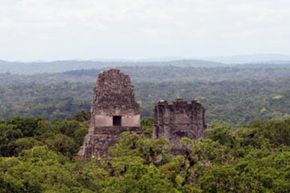What Makes Guatemala...Guatemala?
Guatemala is a mixture of the old and new. Guatemala City, the capital, is very modern and has many high-rise buildings, night clubs, and art galleries, while the rural areas and other pockets of Guatemala still portray an older way of life.
One of the best-known Mayan sites is Tikal, located in northern Guatemala. It's the largest excavated site on the American continent, visited regularly for its temples and vast jungles. What makes it special is that Tikal was one of the most important cultural centers of the Mayan Indians. In fact, Temple IV is the tallest structure in the entire Maya region, standing 231 feet (72 meters) tall [source: Tikal Park].
Advertisement
In Antigua Guatemala or "Old Guatemala", you'll find old ruins and ancient churches representing the Spanish rule. This city was the seat of the Spanish colonial government for the Kingdom of Guatemala and eventually became the most important city in Central America [source: Rutahsa Adventures]. In 1776, earthquakes forced the Spaniards to move the capital to present day Guatemala City.
Spanish is the official language of Guatemala, but many citizens still speak the languages of their ancestors. After the Guatemalan civil war ended in 1996, 24 indigenous languages (dialects of the Mayan language) were officially recognized. Even today, many people cannot speak or understand a language outside of their own.
Guatemalans celebrate the Christian holidays like Christmas and Easter, as well as their own unique celebrations. One holiday that mixes Catholic and pagan influences is the Day of the Dead ceremony. On the last day of October, altars, photographs, candles, flowers, and traditional foods and drinks are placed in Guatemalan homes to honor their deceased loved ones. The ceremony goes into the first day of November when the family members put flowers in front of their doors to welcome the souls of the dead. Afterwards, they travel to the cemeteries to lay wreathes and eat a fiambre (a special vegetable and meat dish) to honor their lost ones [source: Mundo Maya].
In a traditional Guatemalan wedding, the bride and groom are bound together by a silver rope to symbolize their union. The bride and her bridal party all wear white gowns. [Source: Worldwide Wedding Traditions].
Related Articles
Sources
- Aventouras. "Guatemala Food". (August 2, 2011)
- BBC News. "Guatemala Country Profile". BBC.co.uk/news/ (August 2, 2011)
- Casa Alianza. "Big Issue Magazine: Casa Alianza Guatemala Street Children Outreach Programme.'' (August 10, 2011)
- Destinations Points. "Tikal, Guatemala". Desitnationpoint.com (August 10, 2011) http://www.destinationspoint.com/tikal-guatemala/
- Every Culture "Guatemala"..(August 2, 2011)
- Food In Every Country. "Guatemala". Foodbycountry.com (August 10, 2011)
- Guatemala Travel Agency "Mayan Culture". Enjoyguatemala.com. (August 10, 2011)
- International Recipes and Iconic Dishes from Around the World. "Guatemala: Recipes and Cuisine". Whatsforeats.com. (August 12, 2011) http://www.whats4eats.com/central-america/guatemala-cuisine
- Latham, William. "Guatemala: Heart of the Mayan World.'' Adventure Learning Foundation. (August 6, 2011)
- Mayan Kids. "Cities of Pyramids and Enchanted Dwarfs". (August 10, 2011)) http://www.mayankids.com/mkintro.htm
- Mayaparadise.com. (August 6, 2011)
- McLaughlin, Elle. "Facts About Guatemala Food.'' USAToday. (August 6, 2011)
- Mundo Maya. "In Guatemala". Mayadiscovery.com (August 6, 2011)
- Museum of Anthropology. "Mayan Costumes of Guatemala". Anthromuseum.missouri.edu. . (August 2, 2011)
- PBS Newshour. "Timeline: Guatemala's Brutal Civil War". March 7, 2011. (August 6, 2011)
- Rutahsa.com (August 10, 2011) http://www.rutahsa.com/antigua.html
- Thyberg, David. "Traditional Food of Guatemala.'' USAToday. (August 6, 2011)
- The Tikal National Park. "Tikal General Information". Tikalpark.com (August 10, 2011)
- US Department of State. "Background Note: Guatemala". State.gov. (August 2, 2011) http://www.state.gov/r/pa/ei/bgn/2045.htm
- Worldweddingtraditions.com. "Central American Wedding Traditions". (August 10, 2011) http://www.worldweddingtraditions.com/locations/central_american_traditions.html
